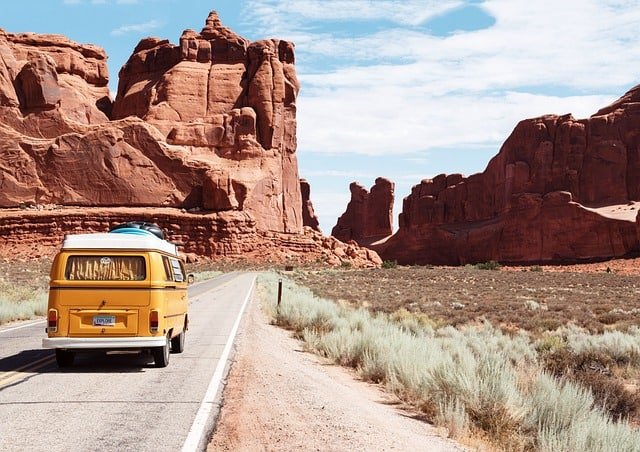Discover the breathtaking beauty of America's famous national parks and preserves as we take you on a journey through the must-see destinations for every nature lover.
Introduction: America's Natural Wonders
The United States is home to a variety of breathtaking natural wonders, from towering mountain ranges and vast deserts to lush forests and pristine lakes. With over 60 national parks spread across the country, it's no wonder America is a top destination for nature lovers and adventure seekers alike. Each park offers a unique experience, showcasing the diverse landscapes and ecosystems of the country. From the iconic geysers of Yellowstone to the towering peaks of Denali, these natural wonders offer a glimpse into the beauty and power of the natural world. Whether you're looking to hike, camp, or simply bask in the splendor of nature, there's something for everyone in America's national parks. So pack your bags, grab your walking shoes and get ready to explore some of the most amazing and awe-inspiring places on Earth.
1. Yellowstone National Park: The place where geysers meet wildlife
Yellowstone National Park is one of the most iconic and recognizable national parks in the United States. Established in 1872, it was the world's first national park and remains one of the most visited today. The park is known for its stunning views, including the famous Old Faithful geyser, which regularly erupts every 90 minutes. But Yellowstone is also home to a wide variety of wildlife, including grizzly bears, wolves, and herds of bison and elk. In fact, Yellowstone is one of the few places in the lower 48 states where visitors can see all the big game species that existed when Europeans first arrived in North America. The park offers a variety of activities, from hiking and camping to fishing and wildlife viewing. One of the best ways to experience the park is on the Yellowstone Loop Road, which offers stunning views of the park's geothermal features, lakes and wildlife. The park is also home to several backcountry campsites, which offer a chance to get away from the crowds and experience the wilderness of the park up close. Whether you are a seasoned nature lover or simply looking for a glimpse of the natural wonders of the world, Yellowstone National Park is not to be missed.
2. 'Grand' is an understatement: Grand Canyon
Few places on earth can match the grandeur and beauty of the Grand Canyon. Carved over millions of years by the Colorado River, the canyon stretches for 277 miles and is up to 18 miles wide in some places. This is undoubtedly one of the most awe-inspiring natural wonders in the world.
- Geological wonder:The Grand Canyon is a geological wonder, displaying nearly two billion years of Earth's history in its colorful rock formations. The rocks at the bottom of the canyon are among the oldest in the world, while those at the top are relatively young. The steep walls of the canyon were shaped over time by the forces of erosion, creating a unique landscape of cliffs, ledges and towers.
- A traveler's paradise:A trip to the Grand Canyon is an adventure like no other. With over 500 miles of trails, there are options for hikers of all abilities. The most popular trail is the Bright Angel Trail, which descends 9.5 miles to the Colorado River. The South Kaibab Trail is another popular option, offering stunning views of the canyon along its 6.4 miles to the river. Those looking for a challenge can try the Rim-to-Rim hike, which spans 24 miles and takes hikers from one side of the canyon to the other.
- Adventure destination:In addition to hiking, the Grand Canyon offers a variety of other outdoor activities, including white water rafting, mule rides, and helicopter tours. White-water rafting trips can take visitors into the heart of the canyon, offering a unique perspective on the landscape. Mule tours are a popular option for those looking to explore the canyon's trails without hiking. And helicopter tours provide a bird's eye view of the amazing scenery of the canyon.
3. Yosemite National Park Yosemite National Park: the land of the giant sequoia
Nestled in California's Sierra Nevada Mountains, Yosemite National Park is a natural wonderland of towering granite cliffs, thundering waterfalls, and ancient forests. The park covers an area of 747,956 dunams and is home to some of the largest and oldest trees in the world, the giant redwoods. These towering platypuses can reach heights of over 300 feet and live for thousands of years, making them some of the most impressive living creatures on Earth.
The park's most famous landmark is Half Dome, a granite dome that rises more than 4,700 feet above the valley floor. Hiking to the top of Half Dome is a challenging but rewarding experience that offers spectacular views of the park's stunning landscape. Another iconic feature of the park is Yosemite Falls, a three-story waterfall that drops a total of 2,425 feet. The waterfalls are especially impressive in the spring when the snowmelt rushes the rivers and streams of the park.
Yosemite is also a haven for wildlife, with over 400 species of animals calling the park home. Visitors can spot black bears, mountain lions, coyotes and fallow deer, among other species. The park is also a paradise for birders, with over 250 species of birds recorded within its borders. One of the most sought-after sightings is the magnificent California condor, one of the rarest birds in North America.
4. Explore the depths of Carlsbad Caverns National Park
Deep under the Guadalupe Mountains in southeastern New Mexico lies one of the most amazing natural wonders in the world: Carlsbad Caverns National Park. This subterranean wonderland is home to over 119 known caves, including the famous Carlsbad Cavern, a massive limestone cave system over 1,000 feet deep. The cave is full of amazing formations such as stalactites, stalagmites and columns, created by the slow trickle of water over millions of years.
Visitors to Carlsbad Caverns National Park can explore the cave system via a series of well-lit trails that wind through the underground chambers. The walk down into the cave is a steep descent, but it is well worth the effort. Along the way, visitors can see incredible formations like the Bottomless Pit, a 140-foot vertical drop, and the Hall of Giants, a room filled with some of the world's largest sentinels.
For those looking for a more adventurous experience, the park offers guided tours that take visitors off the beaten path and into some of the more remote corners of the cave system. These tours range from easy walks to strenuous climbs and require a minimum level of physical fitness.
One of the most unique experiences at Carlsbad Caverns is the night bat flight program. Every evening from Memorial Day through October, thousands of Mexican free-tailed bats leave the cave to hunt insects. Visitors can watch this amazing spectacle from the park's outdoor amphitheater, as the bats swirl upwards into the night sky.
5. Zion National Park: Zion National Park a paradise for travelers?
Zion National Park, located in southwestern Utah, is a true hiker's paradise. The park is home to some of the most amazing hiking trails in the country, with options ranging from easy strolls to challenging multi-day treks. The park's most famous hike is undoubtedly Angel's Landing Trail, a thrilling 5.4-mile trek that takes hikers up a steep, narrow ridge to a breathtaking viewpoint overlooking Zion Canyon.
Besides Angel's Landing, Zion offers plenty of other hiking opportunities for visitors of all skill levels. The park's most popular trail is the Zion Narrows, a hike that takes hikers through the narrowest section of Zion Canyon, wading through the cool waters of the Virgin River. This trip can be completed in one day or as a multi-day backpacking trip, making it a great option for those looking for a longer adventure.
For those looking for a more leisurely hike, the Emerald Pools Trail is an excellent option. This easy, family-friendly trail takes hikers to a series of picturesque pools and waterfalls, surrounded by lush vegetation and towering sandstone cliffs.
In addition to hiking, Zion National Park is also home to a variety of other outdoor activities, including rock climbing, canyoning, and mountain biking. The park's unique landscape and geology make it an ideal destination for these activities, with opportunities for both beginners and experienced adventurers.
6. The Everglades - Everglades National Park: a wetland of international importance
The Everglades is a unique and vast wetland ecosystem located in South Florida. It is considered one of the most important wetlands in the world and has been designated as a UNESCO World Heritage Site, a Biosphere Reserve and a wetland of international importance. The Everglades covers an area of over 1.5 million dunams and is home to a diverse range of plant and animal species.
One of the most unique features of the Everglades is its meandering shallow river system, which flows from Lake Okeechobee to the Gulf of Mexico. This system of rivers is responsible for creating the vast wetland landscape that makes up the Everglades. The wetland is home to a variety of ecosystems, including freshwater marshes, sawgrass prairie, and mangrove forests.
The Everglades are also home to a wide variety of plant and animal species, many of which are found nowhere else in the world. The wetland is home to over 350 species of birds, including the endangered snail kite and tree sparrows. It is also home to a variety of mammals, including the Florida panther, the western walrus, and the American alligator.
In addition to its incredible biodiversity, the Everglades are also an important source of fresh water for South Florida. The wetland acts as a natural filter, removing pollutants and impurities from the water as it flows south. It is also an important source of drinking water for millions of people in the region.
Despite its importance, the Everglades faces a number of threats, including habitat loss, pollution and climate change. These days, efforts are being made to restore and protect the land, including the construction of new water purification facilities and the restoration of natural water flows.
7. Great Smoky Mountains National Park: a paradise for biodiversity
Great Smoky Mountains National Park is located in the southern Appalachian Mountains, spanning Tennessee and North Carolina. It is known for its scenic beauty, rich cultural history and diverse wildlife. The park covers 500,000 acres, making it the largest national park in the eastern United States. It is also home to one of the most biodiverse ecosystems in the world, with over 19,000 recorded species.
The diverse landscape of the park and the varied heights create a unique habitat for a wide variety of plant and animal species. The park is home to over 1,500 species of flowering plants, including flame azalea and mountain laurel. It is also home to a variety of animals, including black bears, moose and river otters.
One of the most unique features of the Great Smoky Mountains National Park is its synchronous fireflies. For a few weeks each year, these fireflies synchronize their flashing lights, creating a stunning display that attracts visitors from around the world.
In addition to its natural beauty, Great Smoky Mountains National Park is also home to a rich cultural history. The park was once home to the Cherokee people, and visitors can explore their history and culture through a variety of exhibits and programs.
Despite its protected status, the Great Smoky Mountains National Park faces several threats, including air pollution, invasive species and climate change. Efforts are being made to deal with these threats, including implementing air quality standards and removing invasive species.
8. The wild beauty of Denali National Park & Preserve - Denali National Park and Preserve
Denali National Park and Preserve is located in the interior of Alaska, and covers 6 million acres. The park is home to the highest peak in North America, Denali, at 20,310 feet. The park is known for its wild wilderness, vast tundra and diverse wildlife.
- The desert experience:
Denali is a true wilderness experience, with only one road leading into the park. Visitors can explore the park by hiking, camping and backpacking, but must be prepared for the rough terrain and harsh weather conditions. - Wildlife viewing:
Denali is home to a variety of wildlife, including grizzly bears, wolves, moose and caribou. One of the best ways to see these animals is through a guided tour or a shuttle bus ride. Visitors can also explore the park's many hiking trails to get a closer look at the park's wildlife. - mountaineering:
For those looking for a more extreme adventure, Denali offers mountain climbing opportunities. Climbing Denali is a challenging endeavor, but the rewards are great for those who reach the top. The climbing season is short, lasting from late April to early July, and requires a permit. Denali National Park and Preserve is also home to a rich cultural history. The park was once home to several indigenous groups, including the Athabaskan people. Visitors can learn about the cultural history of the park through exhibits and programs offered by the park. Despite its protected status, Denali National Park and Preserve faces a number of threats. Climate change is having a significant impact on the park's glaciers, permafrost and wildlife. The park also faces threats from invasive species and air pollution.
9. Glacier National Park: Glacier National Park is the crown of the continent
Glacier National Park is located in the northwest corner of Montana, and covers over a million acres. The park is known for its rocky mountains, glaciers and pristine lakes. The park is also home to a wide variety of wildlife, including grizzly bears, moose and mountain goats.
One of the highlights of Glacier National Park is the Going-to-the-Sun road. This 50-mile road takes visitors on a scenic drive through the park, offering stunning views of the park's mountains, lakes and glaciers. The road is only open from June to October, and visitors are advised to check for road closures before visiting.
Glacier National Park is home to over 700 miles of hiking trails. These trails range from easy walks to challenging treks, offering visitors a chance to explore the wilderness of the park. One of the most popular hikes is the Highline Trail, which takes visitors along the Continental Divide and offers stunning views of the park's mountains.
The park's glaciers are also a major attraction. While the park's glaciers are melting rapidly due to climate change, visitors can still see them up close. One of the best ways to see the glaciers is by taking a guided tour or hiking to one of the glaciers in the park.
Glacier National Park is also home to a rich cultural history. The park was once home to several indigenous groups, including the Blackfeet people. Visitors can learn about the park's cultural history through exhibits and programs offered by the park.
Despite its protected status, Glacier National Park faces several threats. Climate change is having a significant impact on the park's glaciers and wildlife. The park also faces threats from invasive species and air pollution.
10. Acadia National Park: Where the mountains meet the sea.
Acadia National Park is located on Mount Desert Island off the coast of Maine. The park covers 47,000 dunams and is known for its stunning coastal scenery, rocky beaches and granite peaks. The landscape of the park is a unique combination of mountains, forests and coastline, making it a popular destination for nature lovers.
One of the most popular attractions in Acadia National Park is Cadillac Mountain. At 1,530 feet, Cadillac Mountain is the highest point on the East Coast of the United States. Visitors can hike to the top or drive up the winding road to enjoy stunning views of the park's coastline and forests.
The park is also home to over 120 kilometers of hiking trails, ranging from easy walks to challenging treks. One of the most popular hikes is the Headquarters Trail, which takes visitors up a steep cliff to the summit of Mount Champlain. The trail offers stunning views of the park's coastline and forests, but is not recommended for those with a fear of heights.
Acadia National Park is also home to a rich cultural history. The park was once home to several indigenous groups, including the Wabanqui people. Visitors can learn about the park's cultural history through exhibits and programs offered by the park.
The park is also home to a wide variety of wildlife, including moose, black bears and bald eagles. Visitors can explore the park's wildlife through a variety of activities, including wildlife viewing and bird watching.
Despite its protected status, Acadia National Park faces several threats, including climate change and air pollution. The park works to reduce its carbon footprint and protect its fragile ecosystems.
11. The unique ecosystem of Joshua Tree National Park - Joshua Tree National Park
Joshua Tree National Park is located in Southern California and covers 792,000 acres. The park is known for its unique desert landscape, which is home to a variety of plant and animal species. The park is named after the Joshua tree, a tree species native to the park's ecosystem.
The park is divided into two distinct ecosystems: the Mojave Desert and the Colorado Desert. The Mojave Desert is home to the park's namesake Joshua trees, as well as a variety of other plant species adapted to the desert climate. The Colorado Desert, located at a lower elevation, is home to a variety of cactus species and other desert plants.
One of the most popular attractions in Joshua Tree National Park is rock climbing. The park is home to thousands of rock formations, offering climbers a variety of options for all skill levels. The park is also home to a variety of hiking trails, ranging from short hikes to multi-day treks.
Visitors to Joshua Tree National Park can also learn about the park's cultural history. The park was once home to several indigenous groups, including the Cahuilla and Chehuevi people. Visitors can learn about the park's cultural history through exhibits and programs offered by the park.
The park is home to a variety of wildlife, including bighorn sheep, coyotes and desert tortoises. Visitors can explore the park's wildlife through a variety of activities, including wildlife viewing and bird watching.
Despite its protected status, Joshua Tree National Park faces several threats, including climate change and invasive species. The park works to reduce its carbon footprint and protect its fragile ecosystems.
12. Arches National Park - Arches National Park: nature garden and sandstone arches
Arches National Park is located in eastern Utah and is known for its unique rock formations. The park covers 76,000 acres and is home to over 2,000 natural sandstone arches. These arches are the result of erosion over millions of years and are evidence of the power of nature.
The park's most famous landmark is Delicate Arch, a free-standing arch that has become a symbol of Utah. Visitors can see the arch from a distance or hike up to the arch to get a closer look. The hike to Delicate Arch is a moderate 3 mile round trip and offers amazing views of the surrounding landscape.
In addition to the arches, the park is home to a variety of other rock formations, including balanced boulders and sandstone fins. Visitors can explore the park's unique landscape through a variety of activities, including hiking, rock climbing, and mountain biking.
The park is also home to a variety of wildlife, including coyotes, mule deer and bighorn sheep. Visitors can explore the park's wildlife through a variety of activities, including wildlife viewing and bird watching.
Arches National Park is a popular stargazing destination. The park's remote location and lack of light pollution make it an ideal place for stargazing. The park offers a variety of ranger-led educational programs and opportunities, providing visitors with an opportunity to learn about the park's unique geology and natural history.
Despite its protected status, Arches National Park faces several threats, including overuse and climate change. The park works to reduce its carbon footprint and protect its fragile ecosystems.
13. The Rocky Mountain National Park: Rocky Mountain National Park - the Rocky Mountain National Park is a peak experience
Rocky Mountain National Park is a breathtaking destination located in northern Colorado. Home to over 415 square kilometers of pristine wilderness, the park is a mecca for nature lovers and nature enthusiasts. The park is known for its towering peaks, alpine lakes and diverse wildlife.
One of the park's most popular attractions is Trail Ridge Road, a scenic drive that takes visitors over the Continental Divide and through some of the park's most stunning scenery. The road is open seasonally, usually from late May to mid-October, and offers visitors a chance to explore the park's high country.
The park is also home to over 350 miles of hiking trails, ranging from easy hikes to challenging treks. Hikers can explore the park's diverse ecosystems, from the subalpine forests to the alpine tundra. Popular hikes include the Bear Lake Trail and the Emerald Lake Trail.
Rocky Mountain National Park is home to a variety of wildlife, including elk, moose and bighorn sheep. Visitors can spot wildlife in the park's meadows and valleys or on a guided wildlife tour.
The park is also a popular destination for winter sports, including skiing, snowshoeing and ice climbing. Visitors can explore the park's snowy landscapes through a variety of winter activities.
The park offers a variety of ranger-led educational programs and opportunities, providing visitors with an opportunity to learn about the park's unique geology and natural history. Visitors can participate in ranger talks, guided hikes and other educational programs throughout the year.
14. Olympic National Park: Olympic National Park is a world of diversity
Located in the Pacific Northwest region of the United States, Olympic National Park is a world-renowned destination for nature lovers. The park boasts a diverse range of ecosystems, from a rugged coastline to towering mountains, and is home to a variety of wildlife.
One of the park's most unique features is its temperate rainforest, which receives an average of 12 feet of rain per year. The Hoh Rainforest, located on the western side of the park, is a must-visit destination for visitors. The forest is home to towering trees, lush mosses and a variety of wildlife, including Roosevelt elk.
The park is also home to more than 70 miles of rugged coastline, with sea stacks, tide pools and stunning views of the Pacific Ocean. Visitors can explore the beaches and tide pools, or take a walk along the beach on the Ozette Loop Trail.
For mountain climbers, Olympic National Park offers some of the most challenging climbs in the country. The park's highest peak, Mount Olympus, stands at over 7,900 feet and requires technical skills and equipment to reach the summit.
The park is also home to a variety of wildlife, including black bears, mountain goats and bald eagles. Visitors can spot wildlife on a guided tour or hike through the park's diverse ecosystems.
Olympic National Park offers a variety of recreational opportunities, including hiking, camping, fishing, and kayaking. The park is also home to a number of historic sites, including Crescent Lake Lodge and Quinoa Lodge.
15. Hawaii Volcanoes National Park: Hawaii Volcanoes Nation Park witnesses the power of creation
Hawaii Volcanoes National Park, located on the Big Island of Hawaii, offers visitors the opportunity to witness the power of creation firsthand. The park is home to two of the world's most active volcanoes, Kilauea and Mauna Loa, which have been erupting for decades.
Visitors can hike through the park's lava fields, which showcase the geological history of the island. The park offers a variety of trails, from easy hikes to challenging hikes, and visitors can explore the park's unique landscapes, including lava tubes and steam vents.
One of the most popular attractions in the park is the Chain of Craters Road, which offers amazing views of the volcanic landscape. Visitors can also view the park's active lava flows from the Jaggar Museum, which features exhibits on the park's geology and history.
The park is also home to several cultural sites, including ancient Hawaiian petroglyphs and the historic Kilauea Iki Trail. Visitors can learn about the island's rich history and culture at the park's visitor center, which offers exhibits and educational programs.
For those interested in camping, Hawaii's Hawai'i Volcanoes National Park offers a variety of campsites, including drive-in and backcountry options. Visitors can immerse themselves in the park's wilderness and experience the island's unique ecosystem up close.
In addition to its volcanic landscapes, Hawai'i Volcanoes National Park is also home to a variety of plant and animal species, including the endangered Hawaiian goose and the henna. Visitors can explore the park's diverse ecosystems on a guided tour or hike through the park's lush forests.
16. The Great Sand Dunes National Park and Preserve: The Great Sand Dunes National Park and Preserve (in English: Great Sand Dunes National Park and Preserve) desert oasis
Located in southern Colorado, The Great Sand Dunes National Park and Preserve is a unique oasis in the middle of the desert. The park boasts the tallest sand dunes in North America, with some reaching heights of over 750 feet. The dunes are the product of wind and water erosion, and they are constantly changing and changing.
Visitors to the park can hike among the dunes, sandboard the slopes, or even sled down the sandy hills. The park also offers a variety of camping options, from backcountry camping to RV sites, allowing visitors to fully immerse themselves in the park's stunning scenery.
In addition to its sand dunes, the park is also home to a variety of unique ecosystems, including alpine tundra and wetlands. Visitors can explore these diverse environments on a guided tour or by hiking the park's trails.
For those interested in wildlife, Great Sand Dunes National Park and Preserve is home to a variety of animal species, including black bears, mountain lions, and bighorn sheep. Visitors can see these creatures in their natural habitats or learn about them at the park's visitor center.
The park also has a rich cultural history, with evidence of human habitation dating back over 11,000 years. Visitors can explore the park's cultural sites, including ancient ruins and petroglyphs, and learn about the indigenous peoples who once called the area home.
17. Congaree National Park: primary forest
Located in South Carolina, Congery National Park is an ancient forest that has remained undisturbed for centuries. The park is home to one of the few hardwood forests left in the United States, with trees over 150 feet tall and 700 years old.
Visitors to the park can explore the park's walking trails, which wind through the woods and along the Congery River. The park also offers opportunities for canoeing and kayaking, allowing visitors to experience the beauty of the forest from the water.
In addition to its stunning natural beauty, Congeri National Park is also home to a variety of animal species, including otters, bobcats, and woodpeckers. Visitors can see these creatures in their natural habitats or learn about them at the park's visitor center.
One of the park's unique features is the Congaree Boardwalk, a 2.4-mile loop that allows visitors to walk through the heart of the forest and view its towering trees up close. The boardwalk is a popular destination for birdwatchers, as the forest is home to over 200 species of birds.
Congeri National Park also has a rich history, with evidence of human habitation dating back over 12,000 years. Visitors can explore the park's cultural sites, including ancient burial mounds and historic buildings, and learn about the indigenous peoples who once called the area home.
18. Petrified Forest National Park: Petrified Forest National Park Ancient trees that have turned to stone
Petrified Forest National Park, located in northeastern Arizona, is a unique and fascinating destination that attracts visitors from all over the world. The park is known for its amazing scenery and ancient trees that have turned to stone over millions of years.
Petrified Forest National Park is home to a variety of geological formations, including colorful badlands, mesas, and petrified logs. The landscape of the park is the result of millions of years of natural erosion, which has exposed layers of colorful sedimentary rock.
The park's most famous feature, however, is its petrified wood. The fossilized logs in the park are over 200 million years old and were formed when trees were buried by volcanic ash and sediment. Over time, the wood was replaced by silica and other minerals, turning it into stone and creating the beautiful and unique fossilized logs that can be seen today.
One of the best ways to experience the park's Petrified Forest is by hiking one of the park's many trails. The Crystal Forest Trail, for example, takes visitors through a forest of petrified logs, while the Blue Mesa Trail provides stunning views of the park's colorful badlands. Visitors can also view the park's petrified wood from the comfort of their car by driving along the park's scenic drive.
In addition to its geological wonders, Petrified Forest National Park is also home to a variety of wildlife, including pronghorn, coyotes, and bobcats. The park's visitor center offers educational exhibits and programs about the park's history, geology, and ecology.
19. Bryce Canyon - Bryce Canyon National Park is one of the amazing parks!
Bryce Canyon National Park is a unique and picturesque national park located in southwestern Utah in the United States. It is famous for its amazing geological formations called hoodoos, which are tall, thin spiers of rock sculpted by erosion over millions of years. The park encompasses approximately 35,835 dunams (14,502 dunams) and was established on February 25, 1928.
The park's elevation ranges from about 8,000 feet (2,400 meters) to more than 9,100 feet (2,800 meters) above sea level, leading to a variety of ecosystems and habitats, including ponderosa pine forests, grasslands, and high desert areas. The unique geology and colorful rock formations make Bryce Canyon a popular destination for tourists, hikers and photographers.
There are many viewpoints and trails that allow visitors to explore and experience the beauty of the park. Some popular trails include the Mountain Trail, which offers stunning views of the amphitheater, the Queen's Garden Trail, and the Navajo Loop Trail, which takes visitors down into the Canyon of the Indians.
In addition to the amazing geological features, Bryce Canyon is also home to a diverse array of flora and fauna. Visitors can spot mule deer, prairie dogs and golden eagles, as well as a variety of plant species adapted to the park's unique conditions.
Bryce Canyon National Park is a must-see for nature lovers and those interested in the awe-inspiring beauty of the American Southwest. The park is open year-round, but services and facilities may be limited during the winter months due to snow and ice.
National parks and nature reserves in the United States:
| Name | a country | Activities | cost |
|---|---|---|---|
| Grand Canyon National Park | Arizona | Hiking | $35 (about 125 ILS) |
| Yosemite National Park | California | camping | $35 (about 125 ILS) |
| Yellowstone National Park | Wyoming, Montana, Idaho | Wildlife viewing | $35 (about 125 ILS) |
| Acadia National Park | sort out | Mountaineering | $30 (about NIS 105) |
The United States is home to an incredible variety of national parks and nature reserves, each offering unique experiences and unforgettable memories. Don't miss the opportunity to witness the natural wonders of these awe-inspiring places.



















